Popular categories
Looking for a yarn?

100% Wool
from 3.50 £ /50g
Order DROPS Needles & Hooks
Clicking the ORDER button will redirect you to Wool Warehouse Direct Ltd website
The yarn cost is calculated from the pattern’s smallest size and the yarn’s cheapest product type. Looking for an even better price? You might find it on the DROPS Deals!
Rubin
Knitted jumper with Nordic pattern for baby and children in DROPS Merino Extra Fine
DROPS design: Pattern no ME-055-by
Yarn group B
----------------------------------------------------------
Size: 1/3 - 6/9 - 12/18 months (2 - 3/4) years
Size in cm: 56/62 - 68/74 - 80/86 (92 - 98/104)
Materials: DROPS MERINO EXTRA FINE from Garnstudio
Colour no 11, red: 100-100-100 (150-200) g
Colour no 25, pink: 50-50-50 (100-100) g
Colour no 17, cerise: 50-50-50 (100-100) g
DROPS CIRCULAR NEEDLE SIZE 4.5 mm (60 cm) - or size needed to get 20 sts x 26 rows in stocking st = 10 x 10 cm.
DROPS CIRCULAR NEEDLE SIZE 4 mm (60 cm) - for rib.
DROPS DOUBLE POINTED NEEDLES SIZE 4.5 mm – for sleeve.
DROPS DOUBLE POINTED NEEDLES SIZE 4 mm – for rib
-------------------------------------------------------
Alternative Yarn – See how to change yarns here
Yarn Groups A to F – Use the same pattern and change the yarn here
Yarn usage using an alternative yarn – Use our yarn converter here
-------------------------------------------------------

100% Wool
from 3.50 £ /50g
Order DROPS Needles & Hooks
Clicking the ORDER button will redirect you to Wool Warehouse Direct Ltd website
The yarn cost is calculated from the pattern’s smallest size and the yarn’s cheapest product type. Looking for an even better price? You might find it on the DROPS Deals!
- English (UK/cm)
- Česky
- Dansk
- Deutsch
- Eesti keel
- English (US/in)
- Español
- Français
- Íslenska
- Italiano
- Magyar
- Nederlands
- Norsk
- Polski
- Português
- Suomi
- Svenska
- English (UK/cm), Bulgaria
- English (UK/cm), Croatia
- English (UK/cm), Greece
- English (UK/cm), Latvia
- English (UK/cm), Lithuania
- English (UK/cm), Romania
- English (UK/cm), Slovenia
- Česky, Slovakia
Pattern instructions
See diagrams M.1 and M.2.
GARTER ST (back and forth on needle):
K all rows.
INCREASE TIP:
Inc 1 st by making 1 YO, on next round K YO twisted (i.e. work in back loop of st instead front) to avoid holes.
----------------------------------------------------------
BODY:
Worked in the round on circular needle. Cast on 108-120-132 (144-156) sts with red on circular needle size 4 mm. Continue to work rib as follows: * K 1, P 1 *, repeat from *-* for 3-3-3 (4-4) cm. Then switch to circular needle size 4.5 mm and continue in stocking st until finished measurements. When piece measures 4-6-4 (6-6) cm, insert a marker at beg of round and a marker after 54-60-66 (72-78) sts (= sides), and move the marker upwards. REMEMBER THE KNITTING TENSION!
Then work diagram M.1 a total of 2-2-3 (3-4) times vertically. Then work rounds 1-6 in diagram M.1 1-1-1 (1-0) times, and rounds 1-3 in diagram M.2 (piece measures approx. 17-19-21 (23-25) cm). On next round (= 4th round in diagram M.2), cast off 10 sts in each side (i.e. 5 sts on each side of every marker), now divide the piece and finish each part separately.
BACK PIECE:
= 44-50-56 (62-68) sts. Now measure piece from here. Work next row (= RS) as follows: Work 1 st in garter st (= edge st), work 5th row in diagram M.2 until 1 st remains, finish with 1 st in garter st. Continue with diagram M.2 with 1 st in garter st in each side until piece measures 7-8-9 (10-11) cm (NOTE: Continue in stocking st with cerise after last row in diagram M.2 until finished measurements.) Cast off the middle 16-18-20 (20-22) sts for neck and finish each part separately. Cast off 1 st on next row from neck = 13-15-17 (20-22) sts remain on shoulder. When piece measures 9-10-11 (12-13) cm, cast off all sts (back piece measures approx. 26-29-32 (35-38) cm in length).
FRONT PIECE:
= 44-50-56 (62-68) sts. Now measure piece from here. Then continue in diagram M.2 with 1 st in garter st in each side as on back piece. When piece measures 5-6-7 (7-8) cm, cast off the middle 14-14-16 (16-18) sts for neck and finish each part separately. Then cast off on next row from neck as follows: Cast off 1 st 2-3-3 (3-3) times = 13-15-17 (20-22) sts remain on shoulder. When piece measures 9-10-11 (12-13) cm, cast off all sts.
SLEEVE:
Worked in the round on double pointed needles. Cast on 28-30-32 (34-36) sts with red on double pointed needles size 4 mm. Continue to work rib as follows: * K 1, P 1 *, repeat from *-* for 3-3-3 (4-4) cm. Now switch to double pointed needles size 4.5 mm. K next round while at the same time inc 2-0-4 (2-0) sts evenly = 30-30-36 (36-36) sts. READ ALL OF THE FOLLOWING SECTION BEFORE CONTINUING!
Continue in stocking st until piece measures 4-4-6 (7-6) cm. Insert a marker at beg of round (= mid under sleeve) and move the marker upwards. Then work diagram M.1 upwards. When piece measures 5-5-7 (8-7) cm, inc 1 st on each side of marker - Read INCREASE TIP above = 2 new sts worked gradually in pattern. Repeat inc every 8½-5-6½ (4-3½) cm a total of 2-4-3 (5-7) times = 34-38-42 (46-50) sts. Work diagram M.1 a total of 3-3-3 (4-5) times vertically. Then work rounds 1-6 in diagram M.1 0-1-1 (0-0) times, and rounds 1-3 in diagram M.2. Now switch to circular needle size 4.5 mm while at the same time working 4th row in diagram M.2, then divide the piece at the marker and continue working back and forth on needle. On next row, inc 1 st in each side of piece (= 1 edge st in garter st), continue with diagram M.2 between edge sts up to and including the 11th row in diagram M.2 (marked with arrow on chart). With cerise cast off all sts on next row (piece measures approx. 22-24-26 (29-33) cm).
ASSEMBLY:
Sew shoulder seams and sew in sleeves. Knit up along neck edge approx. 60-70 sts with red on double pointed needles size 4 mm. K next round while at the same time adjusting no of sts to 60-62-66 (70-74). Continue to work rib as follows: * K 1, P 1 *, repeat from *-* for 3-3-3 (4-4) cm, then cast off all sts with K over K and P over P. Fold the rib double with the seam on in towards WS and fasten it on the back.
This pattern has been corrected. Click here to see the correction/s.
Correction: Materials: DROPS MERINO EXTRA FINE from Garnstudio
Colour no 11, red: 100-100-100 (150-200) g
Diagram

|
= red |

|
= pink |

|
= cerise |

|
= 11th row in diagram M.2 |
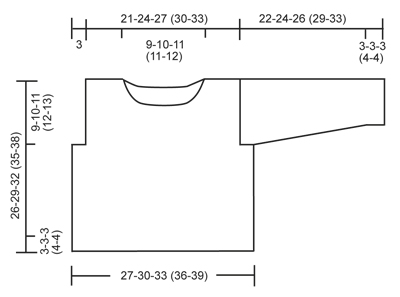
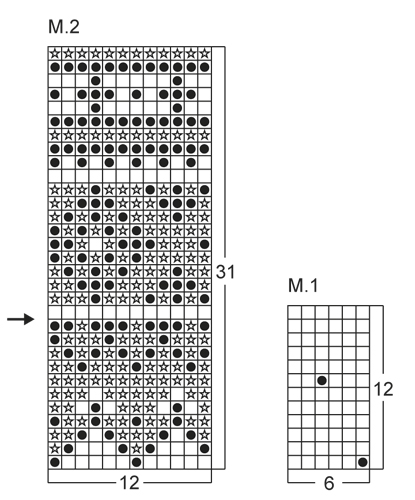
What can you do with our patterns? You can share DROPS patterns online, using the pattern original picture, materials, name and number. But you are NOT ALLOWED to reproduce the complete pattern digitally in any way. Yarn stores are welcome to use the DROPS pattern database to promote the sale of our assortment. You can print out our patterns, make as many copies as you’d like. The only thing we ask is that you don't make any changes / additions to the original printed document. And that the patterns according to the DROPS philosophy are given out to the consumers for free. Editorials that wish to publish our patterns in printed books or magazines can contact us for more information. The sale of garments based on DROPS patterns is permitted as long as they are sold as single items or per order. Further commercial use of the patterns is not permitted. It has to be clearly stated that the garment is made based on a design from DROPS DESIGN. The use of clothing labels of which DROPS DESIGN forms part is conditioned by the inclusion of the following text: “A DROPS DESIGN made by …..”. The use of DROPS photos for marketing purposes/sales is only permitted in connection with the use/sale of DROPS products. The photos may not be cut or edited and the logo should be clearly visible.
We reserve the right to withdraw the permission for use of our patterns at any time, notwithstanding the reason.
Each of our patterns has specific tutorial videos to help you.
These step-by-step tutorials might also help you:
Why is the knitting/crochet tension so important?
Knitting tension is what determines the final measurements of your work, and is usually measured per 10 x 10 cm. It is provided like so: number of stitches in width x number of rows in height - eg: 19 stitches x 26 rows = 10 x 10 cm.
The knitting tension is very individual; some people knit/crochet loosely while others work tightly. You adjust the knitting tension with the needle size, which is why the suggested needle size is only meant as a guide! You need to adjust this (up or down) to ensure that YOUR knitting tension matches the knitting tension provided in the pattern. If you work with a different knitting tension than provided you will have a different yarn consumption, and your work will have different measurements than what the pattern suggests.
The knitting tension also determines which yarns can replace each other. As long as you achieve the same knitting tension you can replace one yarn with another.
See DROPS lesson: How to measure your tension/gauge
See DROPS video: How to make a gauge tension swatch
How do I know how many balls of yarn I need?
The required amount of yarn is provided in grams, eg: 450 g. To calculate how many balls you’ll need you first need to know how many grams are in 1 ball (25g, 50g or 100g). This information is available if you click on the individual yarn quality on our pages. Divide the amount required with the amount of each ball. For example, if each ball is 50g (the most common amount), the calculation will be as follows: 450 / 50 = 9 balls.
Can I use a different yarn than what the pattern suggests?
The important thing when changing from one yarn to another is that the knitting/crochet tension remains the same. This is so that the measurements of the finished piece will be the same as on the sketch provided. It is easier to achieve the same knitting tension using yarns from the same yarn group. It is also possible to work with multiple strands of a thinner yarn to achieve the knitting tension of a thicker one. Please try our yarn converter. We recommend you to always work a test swatch.
Please NOTE: when changing yarn the garment might have a different look and feel to the garment in the photo, due to individual properties and qualities of each yarn.
See DROPS lesson: Can I use a different yarn than the one mentioned in the pattern?
What are the yarn groups?
All our yarns are categorised into yarn groups (from A to F) according to thickness and knitting tension – group A contains the thinnest yarns and group F the thickest. This makes it easier for you to find alternative yarns to our patterns, should you wish to switch yarn. All yarns within the same group have a similar knitting tension and can easily replace each other. However, different yarn qualities have different structures and properties which will give the finished work a unique look and feel.
How do I use the yarn calculator?
At the top of all our patterns you’ll find a link to our yarn calculator, which is a helpful tool should you wish to use a different yarn than suggested. By filling in the yarn quality you wish to replace, the amount (in your size) and number of strands, the calculator will present good alternative yarns with the same knitting tension. Additionally it will tell you how much you’ll require in the new qualities and whether you’ll need to work with multiple strands. Most skeins are 50g (some are 25g or 100g).
If the pattern is worked with multiple colours, every colour will have to be calculated separately. Similarly, if the pattern is worked with several strands of different yarns (for example 1 strand Alpaca and 1 strand Kid-Silk) you will have to find alternatives for each, individually.
Why do you show discontinued yarns in the patterns?
Since different yarns have different qualities and textures we have chosen to keep the original yarn in our patterns. However, you can easily find options among our available qualities by using our yarn calculator, or simply pick a yarn from the same yarn group.
It is possible that some retailers still have discontinued yarns in stock, or that someone has a few skeins at home that they would like to find patterns for.
The yarn calculator will provide both alternative yarn as well as required amount in the new quality.
What size should I knit?
If you think it's hard to decide what size to make, it can be a good idea to measure a garment you own already and like the size of. Then you can pick the size by comparing those measures with the ones available in the pattern's size chart.
You'll find the size chart at the bottom of the pattern.
See DROPS lesson: How to read size chart
Why do I get the wrong knitting tension with the suggested needle size?
The needle size provided in the pattern serves only as a guide, the important thing is to follow the knitting tension. And since knitting tension is very individual, you will have to adjust the needle size to ensure that YOUR tension is the same as in the pattern – maybe you’ll have to adjust 1, or even 2 needle sizes, up or down to achieve the correct tension. For this, we recommend that you work test swatches.
Should you work with a different knitting tension than the one provided, the measurements of the finished garment might deviate from the measurement sketch.
See DROPS lesson: How to measure your tension/gauge
See DROPS video: How to make a tension/gauge swatch
Why is the pattern worked top-down?
Working a garment top-down provides more flexibility and room for personal adjustment. For example it is easier to try the garment on while working, as well as making adjustments to length of yoke and shoulder caps.
The instructions are carefully explaining every step, in the correct order. Diagrams are adjusted to the knitting direction and are worked as usual.
How do I work according to a knitting diagram?
The diagram depicts all rows/rounds, and every stitch seen from the right side. It is read from bottom to top, from right to left. 1 square = 1 stitch.
When working back and forth, every other row is worked from the right side and every other row is worked from the wrong side. When working from the wrong side, the diagram will have to be worked reversed: from left to right, knit stitches are purled, purl stitches are knit etc.
When working in the round every round is worked from the right side and the diagram are worked from right to left on all rounds.
See DROPS lesson: How to read knitting diagrams
How do I work according to a crochet diagram?
The diagram depicts all rows/rounds, and every stitch seen from the right side. It is worked from bottom to top, from right to left.
When working back and forth every other row is worked from the right side: from right to left and every other row is worked from the wrong side: from left to right.
When working in the round, every row in the diagram are worked from the right side, from right to left.
When working a circular diagram you start in the middle and work your way outwards, counter clockwise, row by row.
The rows usually start with a given number of chain stitches (equivalent to the height of the following stitch), this will either be depicted in the diagram or explained in the pattern.
See DROPS lesson: How to read crochet diagrams
How do I work several diagrams simultaneously on the same row/round?
Instructions for working several diagrams after each other on the same row/round, will often be written like so: “work A.1, A.2, A.3 a total of 0-0-2-3-4 times". This means you work A.1 once, then A.2 is worked once, and A.3 is repeated (in width) the number of times provided for your size – in this case like so: S = 0 times, M = 0 times, L=2 times, XL= 3 times and XXL = 4 times.
The diagrams are worked as usual: begin with the first row in A.1, then work the first row in A.2 etc.
See DROPS lesson: How to read knitting diagrams
See DROPS lesson: How to read crochet diagrams
Why are the sleeves shorter in larger sizes?
The total width of the garment (from wrist-to-wrist) will be larger in the larger sizes, despite the actual sleeves being shorter. The larger sizes have longer sleeve caps and wider shoulders, so there will be a good fit in all sizes.
Where on the garment is the length measured?
The measurement sketch/schematic drawing provides information regarding the full length of the garment. If it’s a jumper or a jacket the length is measured from the highest point on the shoulder closest to the neckline, and straight down to the bottom of the garment. It is NOT measured from the tip of shoulder. Similarly, the length of yoke is measured from the highest point on the shoulder and down to where yoke is split into body and sleeves.
On a jacket measures are never taken along bands, unless specifically stated. Always measure inside band stitches when measuring the length.
See DROPS lesson: How to read a schematic drawing
What is a repeat?
Diagrams are often repeated on the round or in height. 1 repeat is the diagram the way it appears in the pattern. If it says to work 5 repeats of A.1 in the round, then you work A.1 a total of 5 times after/next to each other in the round. If it says to work 2 repeats of A.1 vertically/in height you work the entire diagram once, then begin again at the start and work the entire diagram one more time.
Why does the piece start with more chain stitches than it’s worked with?
Chain stitches are slightly narrower than other stitches and to avoid working the cast-on edge too tight, we simply chain more stitches to begin with. The stitch count will be adjusted on the following row to fit the pattern and measurement sketch.
Why increase before the rib edge when the piece is worked top-down?
The rib edge is more elastic and will contract slightly compared to, for example, stocking stitch. By increasing before the rib edge, you avoid a visible difference in width between the rib edge and the rest of the body.
Why increase in the cast-off edge?
It’s very easy to cast off too tightly, and by making yarn overs while casting off (and simultaneously casting these off) you avoid a too tight cast off edge.
See DROPS video: How to bind off with yarn overs (yo)
How do I increase/decrease on every 3rd and 4th row/round alternately?
To achieve an even increase (or decrease) you can increase on, for example: every 3rd and 4th row alternately, like so: work 2 rows and increase on the 3rd row, work 3 rows and increase on the 4th. Repeat this until the increase is complete.
See DROPS lesson: Increase or decrease 1 st on every 3rd and 4th row alternately
How can I work a jacket in the round instead of back and forth?
Should you prefer to work in the round instead of back and forth, you may of course adjust the pattern. You’ll need to add steeks mid-front (usually 5 stitches), and follow the instructions. When you would normally turn and work from the wrong side, simply work across the steek and continue in the round. At the end you’ll cut the piece open, pick up stitches to work bands, and cover the cut edges.
See DROPS video: How to knit steeks and cut open
Can I work a jumper back and forth instead of in the round?
Should you prefer to work back and forth instead of in the round, you may of course adjust the pattern so you work the pieces separately and then assemble them at the end. Divide the stitches for the body in 2, add 1 edge stitch in each side (for sewing) and work the front and back pieces separately.
See DROPS lesson: Can I adapt a pattern for circular needles into straight needles?
Why is the pattern slightly different than what I see in the photo?
Pattern repeats can vary slightly in the different sizes, in order to get the correct proportions. If you’re not working the exact same size as the garment in the photo, yours might deviate slightly. This has been carefully developed and adjusted so that the complete impression of the garment is the same in all sizes.
Make sure to follow instructions and diagrams for your size!
How do I make a women’s size garment into a men’s size one?
If you have found a pattern you like which is available in women’s size it’s not very difficult to convert it to men’s size. The biggest difference will be the length of sleeves and body. Start working on the women size that you think would fit across the chest. The additional length will be worked right before you cast off for the armhole/sleeve cap. If the pattern is worked top-down you can add the length right after the armhole or before the first decrease on sleeve.
Regarding additional yarn amount, this will depend on how much length you add, but it is better with a skein too many than too few.
How do I prevent a hairy garment from shedding?
All yarns will have excess fibres (from production) that might come off as lint or shedding. Brushed yarns (ie hairier yarns) have more of these loose, excess fibres, causing more shedding.
Shedding also depends on what is worn under or over the garment, and whether this pulls at the yarn fibres. It’s therefore not possible to guarantee that there will be no shedding
Below are some tips on how to get the best result when working with hairier yarns:
1. When the garment is finished (before you wash it) shake it vigorously so the looser hairs come off. NOTE: do NOT use a lint roller, brush or any method that pulls at the yarn.
2. Place the garment in a plastic bag and put it in your freezer - the temperature will cause the fibres to become less attached to each other, and excess fibres will come off easier.
3. Leave in the freezer for a few hours before taking it out and shaking it again.
4. Wash the garment according to the instructions on the yarn label.
Why does my garment pill?
Pilling is a natural process that happens to even the most exclusive of fibers. It's a natural sign of wear and tear that is hard to avoid, and that is most visible in high friction areas of your garment like a sweater's arms and cuffs.
You can make your garment look as new by removing the pilling, using a fabric comb or a pill/lint remover.
In the meantime, you can read the questions and answers that others have left to this pattern or join the DROPS Workshop on Facebook to get help from fellow knitters/crocheters!
You might also like...
Rubin |
|||||||||||||
 |
 |
||||||||||||
Knitted jumper with Nordic pattern for baby and children in DROPS Merino Extra Fine
DROPS Baby 21-18 |
|||||||||||||
|
PATTERN: See diagrams M.1 and M.2. GARTER ST (back and forth on needle): K all rows. INCREASE TIP: Inc 1 st by making 1 YO, on next round K YO twisted (i.e. work in back loop of st instead front) to avoid holes. ---------------------------------------------------------- BODY: Worked in the round on circular needle. Cast on 108-120-132 (144-156) sts with red on circular needle size 4 mm. Continue to work rib as follows: * K 1, P 1 *, repeat from *-* for 3-3-3 (4-4) cm. Then switch to circular needle size 4.5 mm and continue in stocking st until finished measurements. When piece measures 4-6-4 (6-6) cm, insert a marker at beg of round and a marker after 54-60-66 (72-78) sts (= sides), and move the marker upwards. REMEMBER THE KNITTING TENSION! Then work diagram M.1 a total of 2-2-3 (3-4) times vertically. Then work rounds 1-6 in diagram M.1 1-1-1 (1-0) times, and rounds 1-3 in diagram M.2 (piece measures approx. 17-19-21 (23-25) cm). On next round (= 4th round in diagram M.2), cast off 10 sts in each side (i.e. 5 sts on each side of every marker), now divide the piece and finish each part separately. BACK PIECE: = 44-50-56 (62-68) sts. Now measure piece from here. Work next row (= RS) as follows: Work 1 st in garter st (= edge st), work 5th row in diagram M.2 until 1 st remains, finish with 1 st in garter st. Continue with diagram M.2 with 1 st in garter st in each side until piece measures 7-8-9 (10-11) cm (NOTE: Continue in stocking st with cerise after last row in diagram M.2 until finished measurements.) Cast off the middle 16-18-20 (20-22) sts for neck and finish each part separately. Cast off 1 st on next row from neck = 13-15-17 (20-22) sts remain on shoulder. When piece measures 9-10-11 (12-13) cm, cast off all sts (back piece measures approx. 26-29-32 (35-38) cm in length). FRONT PIECE: = 44-50-56 (62-68) sts. Now measure piece from here. Then continue in diagram M.2 with 1 st in garter st in each side as on back piece. When piece measures 5-6-7 (7-8) cm, cast off the middle 14-14-16 (16-18) sts for neck and finish each part separately. Then cast off on next row from neck as follows: Cast off 1 st 2-3-3 (3-3) times = 13-15-17 (20-22) sts remain on shoulder. When piece measures 9-10-11 (12-13) cm, cast off all sts. SLEEVE: Worked in the round on double pointed needles. Cast on 28-30-32 (34-36) sts with red on double pointed needles size 4 mm. Continue to work rib as follows: * K 1, P 1 *, repeat from *-* for 3-3-3 (4-4) cm. Now switch to double pointed needles size 4.5 mm. K next round while at the same time inc 2-0-4 (2-0) sts evenly = 30-30-36 (36-36) sts. READ ALL OF THE FOLLOWING SECTION BEFORE CONTINUING! Continue in stocking st until piece measures 4-4-6 (7-6) cm. Insert a marker at beg of round (= mid under sleeve) and move the marker upwards. Then work diagram M.1 upwards. When piece measures 5-5-7 (8-7) cm, inc 1 st on each side of marker - Read INCREASE TIP above = 2 new sts worked gradually in pattern. Repeat inc every 8½-5-6½ (4-3½) cm a total of 2-4-3 (5-7) times = 34-38-42 (46-50) sts. Work diagram M.1 a total of 3-3-3 (4-5) times vertically. Then work rounds 1-6 in diagram M.1 0-1-1 (0-0) times, and rounds 1-3 in diagram M.2. Now switch to circular needle size 4.5 mm while at the same time working 4th row in diagram M.2, then divide the piece at the marker and continue working back and forth on needle. On next row, inc 1 st in each side of piece (= 1 edge st in garter st), continue with diagram M.2 between edge sts up to and including the 11th row in diagram M.2 (marked with arrow on chart). With cerise cast off all sts on next row (piece measures approx. 22-24-26 (29-33) cm). ASSEMBLY: Sew shoulder seams and sew in sleeves. Knit up along neck edge approx. 60-70 sts with red on double pointed needles size 4 mm. K next round while at the same time adjusting no of sts to 60-62-66 (70-74). Continue to work rib as follows: * K 1, P 1 *, repeat from *-* for 3-3-3 (4-4) cm, then cast off all sts with K over K and P over P. Fold the rib double with the seam on in towards WS and fasten it on the back. |
|||||||||||||
Diagram explanations |
|||||||||||||
|
|||||||||||||

|
|||||||||||||

|
|||||||||||||
|
Have you made this or any other of our designs? Tag your pictures in social media with #dropsdesign so we can see them! Do you need help with this pattern?You'll find tutorial videos, a Comments/Questions area and more by visiting the pattern on garnstudio.com. © 1982-2024 DROPS Design A/S. We reserve all rights. This document, including all its sub-sections, has copyrights. Read more about what you can do with our patterns at the bottom of each pattern on our site. |
|||||||||||||
With over 40 years in knitting and crochet design, DROPS Design offers one of the most extensive collections of free patterns on the internet - translated to 17 languages. As of today we count 304 catalogues and 11422 patterns - 11422 of which are translated into English (UK/cm).
We work hard to bring you the best knitting and crochet have to offer, inspiration and advice as well as great quality yarns at incredible prices! Would you like to use our patterns for other than personal use? You can read what you are allowed to do in the Copyright text at the bottom of all our patterns. Happy crafting!








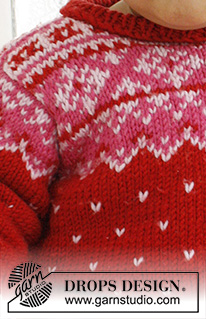

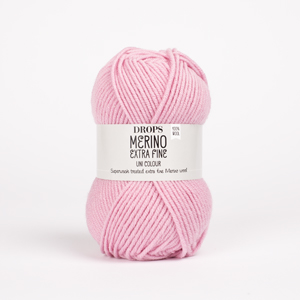
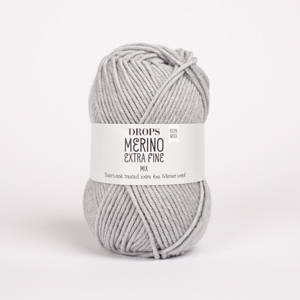

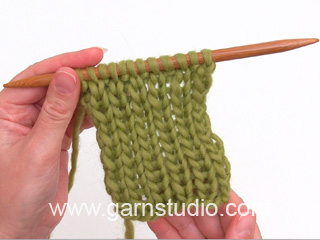


































Comments / Questions (36)
Firstly thank you for sharing your beautiful free patterns. I am knitting size 2 and have a probem with the sleeve. With the back I made the armhole 12cm per the pattern. When I knitted the sleeve I worked up to row 11 of the pattern but the length of the sleeve from when its worked back and forth is only 5cm. I just can't figure out where I have gone wrong. Any assistance would be really appreciated. Regards Jeanette
21.04.2024 - 06:24DROPS Design answered:
Dear Jeanette, if you work according to the pattern it should all be correct. The part of the sleeve worked back and forth is sewn over the 10 sts cast off in the body in each side. The width of the top of the sleeve should have a circunference of 24cm to join it to the 12 cm armhole. Happy knitting!
22.04.2024 - 01:08Hva mener dere med går over 6 masker i M2… synes det er ufattelig dårlig forklart i både oppskrift og kommentarfeltet… Strikker 12/18 mnd . Og er i M2 bakstykket med 66 masker .. kan dere forklare med teskje ? 😅 Og hvilken farge skal kantmaskene i rille strikkes i?
23.01.2024 - 00:45DROPS Design answered:
Hej Kjerstin, vi kan slet ikke finde hvor du er i opskriften, hvor skriver vi går over 6 masker?
02.02.2024 - 13:37Stickarbaby21-18 får inte mönstret att stämma efter 12 varv varvar från höger o vanster sida vartannat varv men får inte mönstret att stämma har stickat om så många gångerär ingen nybörjare på att sticka men....snart ger jag upp
16.09.2023 - 11:56DROPS Design answered:
Hei Gun. Når du har felt til ermhull og har xx antall masker i den str du strikker, så pass på at mønstret stemmer overens og at det strikkes 1 masker i riller i hver side. I f.eks 1/3 mnd har du felt de første 5 maskene og starter da med 1 maske rille i 6. maske i diagram M.2. Så strikker du de neste 6 maskene i M.1 + M.1+M.1+M.1 + 1 maske i rille = 44 masker. mvh DROPS Design
26.09.2023 - 11:35Hej! Jag stickar tröjan i storlek 12/18 månader. Enligt mönstret ska det räcka med 100 g i det röda, men för mig gick det garnet åt till fram- och bakstycke. Mvh Annica
24.02.2023 - 11:18Jeg strikker str. 12/18 mrd. Jeg er igang med at strikket ryg & forstyr og skal til at strikke M2, men der er 66 masker på både ryg og forstyr og diagrammet har 12 masker og det går ikke op. Hvad skal man gøre?
01.09.2022 - 20:09DROPS Design answered:
Hej Pia, jo men de første omgange i M.2 går mønsterrapporten kun over 6 masker :)
02.09.2022 - 14:41When I divide the jumper to do the back and front separately do I continue to use a circular needle or change to straight needles doing knit and purl rows as right side is mentioned. It doesn’t mention a needle change . Also do I put the front stitches on a holder whilst doing the back?
03.07.2021 - 20:16DROPS Design answered:
Dear Avril, actually it is up to you. You can leave half of the stitches on the needle, and keep knitting on the other half. If you find this uncomfortable, you can put half of the stitches on a stitch-holder, a piece of therad, or another circular needle. Happy Knitting!
04.07.2021 - 00:42Hello, I am a little bit confused, I got to the part where I cast off and then the piece is divided into front and back. Im making the size12-18month. How to follow M2 as I have 56sts and the pattern is a repeat of 12sts I have 8 stst left the design won't be even? Even with the garter stich its not even, and is the garter stitch knitted with the main colour?
15.04.2021 - 14:02DROPS Design answered:
Dear Nora, contine M.é so that the first stitch xorked in M.2 is lined up over the previous stitvh in M.2 that shouldn't be the 1st one anymore; ie start 1st repat frm that st to the left, repeat deiagram as before over the next sts; note the last st on row worked in M.2; this will be the first st to work from WS (reading diagram from the left towards the right). Happy knitting!
15.04.2021 - 15:22Hei, jeg ser at i oppskriften for 6/9 mnd. Så skal en starte med 30 m vrangbord og avslutte med 24 m. Dette får jeg ikke til å stemme, håndleddet er jo ikke mindre enn selve skulderen, det er motsatt. Den er ikke kompatibel med bolen der en ifølge oppskriften skal avslutte skulderen med 60 m, som siden skal monteres fast til 24 m. Fint om dere kan ta en ny gjennomgang av oppskriften. Mvh Paula
30.08.2020 - 11:24DROPS Design answered:
Hej Paula, jo men det stemmer, du må tælle hele omkredsen på ærmet med. Ærmet er strikket med en lille ærmekuppel, så siderne på ærmekuplen skal sidde rundt i ærmegabet. Husk at du skal lukke løst af. God fornøjelse!
02.09.2020 - 14:32Varför ska man dela på ärmen mitt under? Och hur är tanken att man ska man fästa ärmarna i oket?
26.03.2020 - 15:16DROPS Design answered:
Hei Johanna. Man deler ermene mitt under, slik at det blir en bedre passform på ermene /genseren, se evnt målskissen hvordan det er tenkt. Ermene sys fast i bolen med pene sting. Se gjerne på hjelpevideoene til oppskriften. God Fornøyelse!
30.03.2020 - 14:02Nu har jag stickat bakstycket och höger axel,. Hur är tanken att man ska få över garntrådarna till vänster axel? Måste man klippa av trådarna och "börja om" på vänster axel? Eller finns det något smidigare sätt?
22.03.2020 - 08:19DROPS Design answered:
Hej Ja efter att du stickat höger axel färdig får du klippa av tråden och sticka den andra axeln. Mvh DROPS Design
25.03.2020 - 11:36